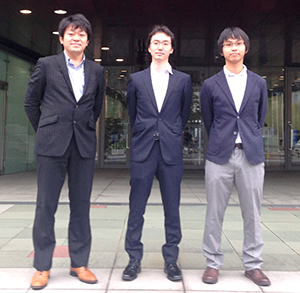Apr. 27, 2018 Research Highlight Biology
Massive Japanese genetic analysis links genes, cell types and disease
A huge genetic study could lead to diagnostic tests customized to people in Japan
 Figure 1: By analyzing the DNA of more than 162,000 Japanese people, researchers have discovered new connections between genes and diseases in the Japanese population. © MINT IMAGES/SCIENCE PHOTO LIBRARY
Figure 1: By analyzing the DNA of more than 162,000 Japanese people, researchers have discovered new connections between genes and diseases in the Japanese population. © MINT IMAGES/SCIENCE PHOTO LIBRARY
In one of the largest genetic studies ever to come out of Asia, RIKEN scientists have scoured the DNA of more than 162,000 Japanese people and identified a whopping 1,407 spots in the genome that affect 58 clinical quantitative traits, including laboratory measurements1. The findings could help diagnostic laboratories produce genetic tests tailored to the Japanese population.
Prior genetic analyses of this kind have mostly involved people of European descent, who are genetically distinct and not necessarily representative of populations found elsewhere in the world. That explains why only 728 of the trait-associated gene regions singled out by the RIKEN team had been documented before—the other 679 were completely new to science.
The researchers also combined the data from their massive investigation with that of 32 genetic studies of assorted complex diseases to link genes expressed in particular cell types with specific diseases. “Some of these genes may be risk factors for diseases and the genetic variants in these genes could be used to predict an individual’s chance of developing a disease in the future,” says Yoichiro Kamatani of the RIKEN Center for Integrative Medical Sciences.
The research was possible thanks to the BioBank Japan Project, which is second only to the UK Biobank in size and richness of genetic data. That resource allowed the team to study DNA from a group that would fill Tokyo Dome baseball stadium about three times over. It also provided a uniform platform with which to examine dozens of different traits simultaneously, without differences in genetic architecture or sample size, which can limit the usefulness of multiple single-disease studies conducted in parallel.
 Yoichiro Kamatani (left), Yukinori Okada (center) and Masahiro Kanai (right), with co-workers, have discovered more than 1,400 genomic regions linked to health-related traits of all kinds. © 2018 RIKEN
Yoichiro Kamatani (left), Yukinori Okada (center) and Masahiro Kanai (right), with co-workers, have discovered more than 1,400 genomic regions linked to health-related traits of all kinds. © 2018 RIKEN
The RIKEN-led team found many genes that affected more than one trait. For example, the ALDH2 gene, which encodes an enzyme involved in alcohol metabolism, was associated with 21 traits across 7 different biological categories. Another gene, RGS12, was implicated in kidney function, blood calcium levels, platelet counts, liver enzymes and other essential body functions.
To better understand the role of these genes, the researchers cross-referenced their combined dataset with cell-type-specific maps of epigenetic markers that denote which parts of the genome are active and which are silenced. This allowed them to show, for example, which genes that contribute to allergies are active in immune cells and which genes involved in blood disorders are active in red blood cells.
“Genetic studies of human samples, along with epigenetics data, can depict the relationship between traits and cell types,” Kamatani says. “And we did that for a non-European population, which is unique.”
Related contents
- Genes, disease and ethnicity
- Mapping disease genes to immune cells
- Keeping an eye on the Japanese genome
References
- 1. Kanai, M., Akiyama, M., Takahashi, A., Matoba, N., Momozawa, Y., Ikeda, M., Iwata, N., Ikegawa, S., Hirata, M., Matsuda, K. et al. Genetic analysis of quantitative traits in the Japanese population links cell types to complex human diseases. Nature Genetics 50, 390–400 (2018). doi: 10.1038/s41588-018-0047-6
